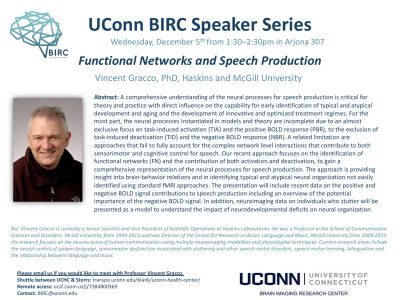UConn Health Patients Can Now Get MRIs at UConn in Storrs
UConn Health patients in eastern Connecticut will now be able to get MRI scans done in Storrs just as if they were at UConn Health in Farmington, thanks to a collaboration between doctors and researchers at the two campuses.
UConn’s Brain Imaging Research Center (BIRC) houses a powerful 3 Tesla Magnetic Resonance Imaging (MRI) scanner that was installed in 2015 and originally dedicated purely to research. The BIRC’s machine can take detailed pictures of fine structures in the brain. It can also do functional MRI, which shows subtle changes in blood flow in the brain as a person thinks. Medical details – tiny flecks of blood that might signal a concussion, or small injuries to the spine or extremities – also show up beautifully on the scanner. But the state had not previously licensed the BIRC’s machine to perform medical work. Doctors at UConn Health and researchers at the BIRC thought that should change.
“Soon after I started as chair, it became clear we had a long history of our UConn Husky athletes having scans done on the outside. But then their docs would bring the scans to us for a second read because they trusted us,” says Dr. Leo Wolansky, head of radiology at UConn Health. “It’s our moral obligation to take care of our own people,” but it was a lot of unpaid work too, he observes. Other patients in eastern Connecticut, including students, staff, and faculty, who wanted to use UConn Health doctors but worked and lived near Storrs also found it inconvenient to drive to Farmington for a scan. That meant a lot of UConn money leaving the institution, Wolansky adds, an undesirable phenomenon known as “leakage.”
So he began working with former BIRC scientific directors Inge-Marie Eigsti and Jay Rueckl, and more recently BIRC director Fumiko Hoeft, along with regulatory and business development staff at UConn Health, to get permission from the state to use the center’s machine for medical imaging. Then, with the help of UConn Health MRI technologist Brian Hausner, MRI service manager Elisa Medeiros installed protocols to run clinical scans. The picture archiving communication system team at UConn Health oversaw the setup of the hardware needed to transmit medical data securely from the BIRC, which is located in the Phillips Communication Sciences Building in Storrs, to UConn Health in Farmington.
It took months of work, but on Nov. 7, the BIRC scanned Clinical MRI Patient #1. The term “Clinical MRI Patient #1” had a double meaning. It referred to the first clinical scan chronologically, but it was also a HIPAA-compliant way to refer to the top executive at UConn, President Herbst, who agreed to be the “test case.” She has given permission to publish this information, and wants everyone to know she’s fine.
“The President’s support of the project was critical,” says Wolansky.
UConn Health doctors can now schedule MRIs for their patients at the BIRC in Storrs for Monday and Wednesday afternoons as easily as if they were going to the imaging center in Farmington. Urgent scans can be squeezed in at other times on a case-by-case basis. The BIRC capacity will free up some space at UConn Health, bringing new patients into the system, and is not expected to impact research done at the center at all.
“The biggest benefit is the integration between campuses. It’s a huge success for us to do this,” says Hoeft, the director of BIRC, noting that revenue from the scans will enhance the financial stability of the center.
Wolansky, who is based in Farmington, agrees. UConn’s Farmington and Storrs campuses function largely independently from one another, so this collaboration is based on goodwill, he says.
“They are UConn and we are UConn,” he adds. “Even though [patients] may be 40 minutes away by car, when we read the scans [at the imaging center in Farmington], it’s no different than if the patients were down the hall!”
This story was originally published in UConn Today

